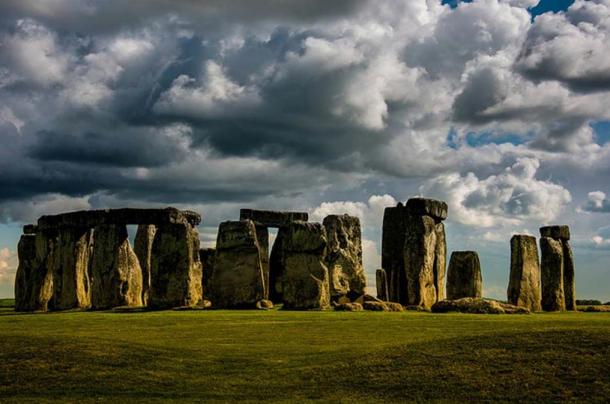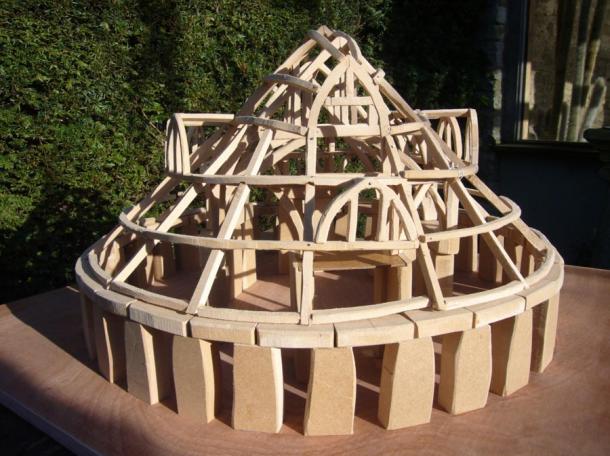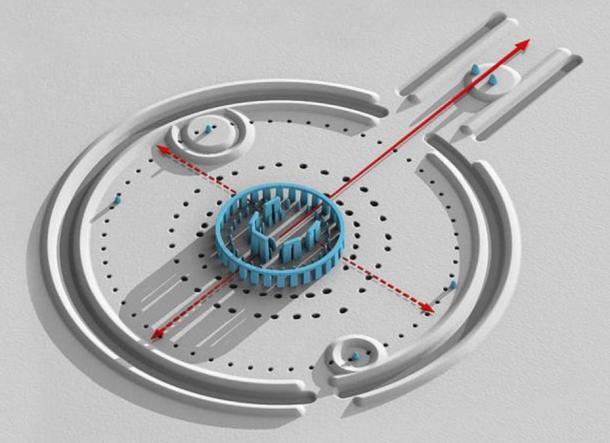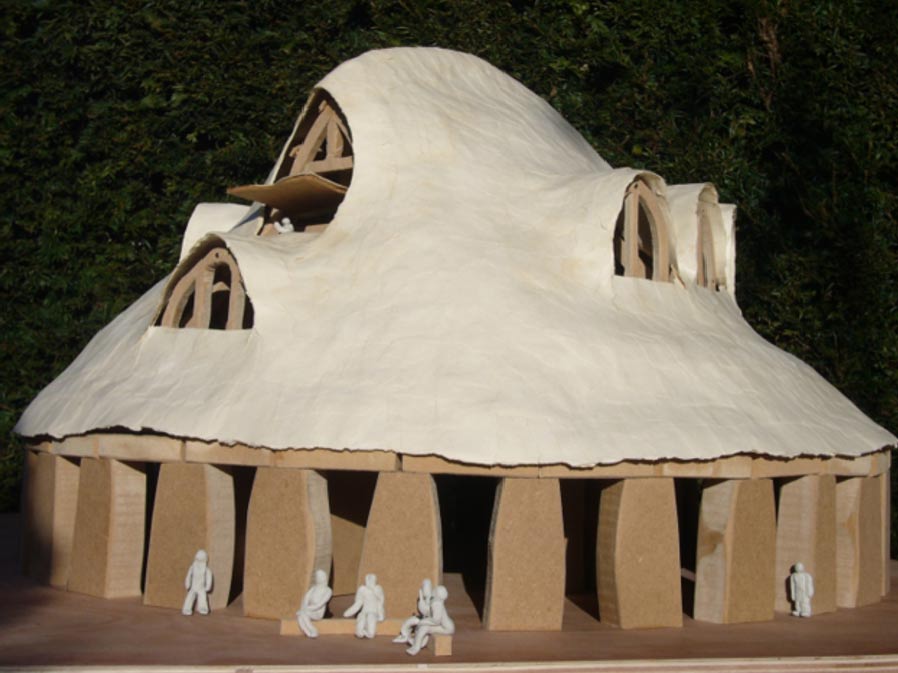Architect presents radical new theory that Stonehenge was a two-storey, wooden feasting and performance hall
Could the prehistoric Stonehenge megaliths once have been the support for a wooden, two-storey roundhouse, a venue for feasting, speakers and musicians? That’s the theory of an English landscape architect who designed a small model of what she has in mind and is looking for money to build a 1:10 scale model of the structure.
Sarah Ewbank says the fact she is not an archaeologist has freed her from preconceived notions and allowed her to approach the matter in a fresh way.
Ms Ewbank told Ancient Origins via email about her vision of Stonehenge:
“I believe Stonehenge was a Bronze-age venue, a large oval hall encircled and overlooked by galleries. Interestingly the upper level was tiered, the height of different sections reflecting the different height trilithons. Consider both hall and galleries filled, listening to a speaker, or maybe there was feasting on the galleries with dancing below, perhaps crowds gathered to listen to singing or musicians playing, or maybe ceremonies took place to welcome in the solstices. It all sounds rather splendid and certainly needed – there were no electronic gadgets then!
My view – such a splendid building deserved to be used often – so, much as the Albert Hall in London serves to accommodate every type of gathering, so I believe our Bronze-age ancestors used Stonehenge whenever such a venue was required. Our bronze-age ancestors were intelligent people with needs similar to ours today. Forget the furry loin cloth and ritual sacrifice stuff – it’s wrong.”
She said she’s discussed her theories with other experts. Some of them agree with her interpretation of the building’s use, but others strongly disagree and argue for the traditional view.

The way the monument looks today . Howard Ignatius/ Flickr
Ms. Ewbank speculates that the sides of the house were made of oak and the roof of thatching. Of course, it is highly unlikely wood or straw would survive the thousands of years of Stonehenge’s existence, so finding physical evidence for her theory—other than the layout of the stones themselves—is next to impossible.
In fact, she says on her website people have asked her if there is evidence of a roof. She points out that 500-year-old abbeys have roofs missing. “So don’t expect to find the timber structure lying around after 4,000 years,” she said.
“When you look at it the whole thing it fits absolutely perfectly,” she’s quoted as saying in SalisburyJournal. “I haven’t had to push one stone out of place. I have just taken all the standing stones and it all fits.”

Ms. Ewbank’s model without the roofing ( Photo copyright Sarah Ewbank )
She lists several reasons on her website for theorizing the monument was a roundhouse, including:
- One of the stones is called the “lintel stone,” apparently for an important reason.
- The blue-stones have grooves in them for structural purpose.
- The trilithons are spaced just right to support four large trusses. The height difference between the trilithons allowed raising of the trusses.
Ms. Ewbanks writes on her blog:
To form the large trusses, only eight 15-baunt (16-metre) oak timbers with angled profile are required. Bronze-age oaks were very likely bigger and better than those available today. Apparently ship-building in past-times robbed the UK of the good-sized oaks! Before discounting this idea ask yourself, ‘If Bronze-age people are capable of quarrying, moving and shaping stones that weigh 20 to 50 tonnes, can they fell and oak and shape the timber to form a roof?’ The answer can only be yes.
She told SalisburyJournal:
“Archaeologists are very obsessed with dating and the meaning of it. I looked at it and thought it was a ruin, and that with my design skills I could work out what was there. In our climate back in the Bronze Age it still rained, and why would you move 75 large stones just so you could dance around twice a year? If you put a roof on it you can use it all year.”
And those ancient people apparently moved those stones quite a distance. Archaeologists announced in December 2015 that they found the exact holes in a rocky outcrop in Wales from where the bluestones found at Stonehenge originated, revealing that they were quarried 500 years before they were assembled into the famous stone circle that still stands today in Wiltshire, England. The dramatic discovery suggests that some of the stones making up the ancient monument was first erected as a structure in Wales and later dismantled, transported, and reassembled over 140 miles away in Salisbury Plain.

Computer rendering of the overall site of Stonehenge and surrounds. Public Domain
The Guardian reports that the finding was made during a project run by the University College London (UCL), in cooperation with the universities of Manchester, Bournemouth and Southampton, among others, to investigate quarries in the Preseli Hills in Pembrokeshire, Wales.
It has long been known that the bluestones – a term used in a loose sense to cover all of the ‘foreign’ stones which are not native to Salisbury Plain – originated in southwest Wales. Their name actually refers to the spotted dolerite, an igneous rock that looks blue when broken and is spotted with small pellets of feldspar and other minerals that got into the molten matrix when the rocks were forming geological ages ago. Nearly a century ago, in 1923, the eminent petrographer, Herbert Thomas, was able to identify their source as the Preseli hills .
Another scholar, Julian Spalding, theorized recently that the Stonehenge we know today may have been merely the support for a series of elevated wooden platforms. These platforms could have been used for spiritual ceremonies, elevating religious leaders off the ground – bringing humans closer to the heavens and the gods.
Art critic, historian and former curator Spalding said to The Guardian : “In early times, no spiritual ceremonies would have been performed on the ground. The Pharaoh of Egypt and the Emperor of China were always carried – as the Pope used to be. The feet of holy people were not allowed to touch the ground. We’ve been looking at Stonehenge from a modern, earth-bound perspective.”
No physical evidence has been found to back up the historian’s claim.
The exact purpose of Stonehenge is not known, but some researchers believe it was built as an ancient calendar to mark seasons and the movements of the sun and moon. Others say it was a place of healing, or dying, or perhaps a place of worship.
Related Post
A shocking documentary proves that mermaids do exist
SHOCKING Revelation: Thuya, Mother of Queen Tiye, Was the Grandmother of Akhenaten and Tutankhamun—What Ancient Egyptian Secrets Did She Leave Behind?
Breaking News: Astonishing Discoveries at Karahan Tepe Confirm an Extraterrestrial Civilization is Hiding on Earth, and NO ONE Knows!
Breaking News: Researchers FINALLY Discover U.S. Navy Flight 19 After 75 Years Lost in the Bermuda Triangle!
NASA’s Secret Investigation: Uncovering the Astonishing Mystery of the UFO Crash on the Mountain!
Explosive UFO Docs LEAKED: Startling Proof That Aliens Ruled Ancient Egypt!
